Instructions for Side by Side Printing
- Print the notecards
- Fold each page in half along the solid vertical line
- Cut out the notecards by cutting along each horizontal dotted line
- Optional: Glue, tape or staple the ends of each notecard together
Physics 2 exam 1
front 1 A spherical surface surrounds a point charge q. Describe what happens to the total flux through the surface if the following happens: The charge is tripled. A)The flux is tripled. B)The flux decreases by 1/3. C)The flux remains constant. D)The flux goes to zero. | back 1 A |
front 2 A spherical surface surrounds a point charge q. Describe what happens to the total flux through the surface if the following happens: The volume of the sphere is doubled. A)The flux is tripled. B)The flux decreases by 1/3. C)The flux remains constant. D)The flux goes to zero. | back 2 C |
front 3 A spherical surface surrounds a point charge q. Describe what happens to the total flux through the surface if the following happens: The volume of the sphere is doubled. A)The flux is tripled. B)The flux decreases by 1/3. C)The flux remains constant. D)The flux goes to zero. | back 3 C |
front 4 A spherical surface surrounds a point charge q. Describe what happens to the total flux through the surface if the following happens: The charged is moved to another location inside the surface. A)The flux is tripled. B)The flux decreases by 1/3. C)The flux remains constant. D)The flux goes to zero. | back 4 C |
front 5 A spherical surface surrounds a point charge q. Describe what happens to the total flux through the surface if the following happens: The charge is moved outside the surface. A)The flux is tripled. B)The flux decreases by 1/3. C)The flux remains constant. D)The flux goes to zero. | back 5 D |
front 6 What happens when a charged insulator is placed near an uncharged metallic object? A)They exert no electrostatic force on each other. B)They repel each other. C)They attract each other. D)They may attract or repel each other, depending on whether the charge on the insulator is positive or negative. E)The charged insulator always spontaneously discharges. | back 6 C |
front 7 If an electron is released from rest in a uniform electric field, the electric potential energy of the charge-field system does what? A)increases B)decreases C)remains the same | back 7 B |
front 8 A spherical balloon contains a positively charged particle at its center. As the balloon is inflated to a larger volume while the charged particle remains at the center, which of the following are true? A)The electrical potential at the surface of the balloon increases. B) None of these. C) The electric flux through the balloon remains the same. D) The magnitude of the electric field at the surface of the balloon increases. | back 8 C |
front 9 An electron initially at rest accelerates through a potential difference of 1 V, gaining kinetic energy KEe, whereas a proton, also initially at rest, accelerates through a potential difference of - 1 V, gaining kinetic energy KEp. Which of the following relationships holds? A)KEe = KEp B) KEe > KEp C) KEe < KEp D) Cannot be determined from the given information. | back 9 A |
front 10 A suspended object A is attracted to a neutral wall. It's also attracted to a positively charged object B. Which of the following is true about object A? A)It is uncharged. B)It has a negative charge. C)It has a positive charge. D) It may be either charged or uncharged. | back 10 B |
front 11 Object A has a charge of +2uc, and object B has changed of + 6 uC which statement is true? A) F=-3F B)F=-F C)3F=-F | back 11 B |
front 12 A test charge of +3uc is at a point P where the electric field due to other charges is directed to the right and has a magnitude of 4*10^6 N/C. If the rest charge is replaced with a charge of -3uc, the electric field at P. a) has the same magnitude before , but changes direction. b) increases in magnitude and changes direction c)remains the same d) decreases in magnitude and changes direction | back 12 C |
front 13 A circular ring of charge of radius b has a total charge q uniformly distributed around it. Find the magnitude of the electric field in the center of the ring. a)0 b)Keq/b^2 c)Keq^2/b^2 d)Keq^2/b e) None of these are the correct answer | back 13 A |
front 14 A free electron and a free proton are placed in an identical electric field. Which of the following statements are true a) Each particle is acted upon by the same electric force and has the same acceleration. b) The electric force on the proton is greater in magnitude than the electric force on the electron, but in the opposite direction c) The electric force on the proton is equal in magnitude to the electric force on the electron, but in the opposite direction. d) The magnitude of the acceleration of the electron is greater than that of the proton e)Both particles have the same acceleration. | back 14 C and D |
front 15 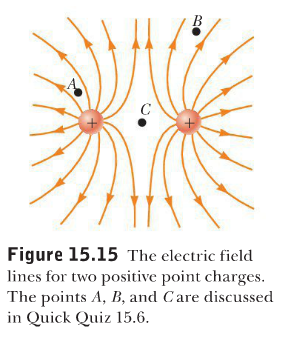 Rank the magnitudes of the field at points, A,B and C in figure 15.15 with the largest magnitude first. a) A,B,C b) A,C,B c)C,A,B d) The answer can't be determined by visual inspection. | back 15 A |
front 16 Calculate the magnitude of the flux of a constant electric field of 5.00 N/C in the z-direction through a rectangle with area 4.00m^2 in the xy-plane. a)0 b)10,0 Nm^2/C c) 20.0 Nm^2/C d) more information is needed | back 16 C |
front 17 Calculate the magnitude of the flux of a constant electric field of 5.00 N/C in the z-direction through a rectangle with area 4.00m^2 in the xy-plane.Suppose the electric field of Quick Quiz 15.7 is titled 60 degrees away from the positive z-direction. Calculate the magnitude of the flux through the same area. a)0 b)10,0 Nm^2/C c) 20.0 Nm^2/C d) more information is needed | back 17 B |
front 18 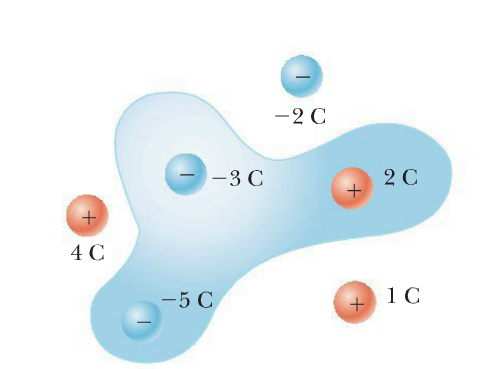 Find the electric flux through the surface in the figure. Assume all charges in the shaded area are inside the surface. a)-(3C)/e0 b)(3C)/e0 c)0 d)(-6C)/e0 | back 18 D |
front 19 For a closed surface through which the net flux is zero, each of the following four statements could be true. Which of the statements must be true? a)There are no charges inside the surface b) The net charge inside the surface is zero. c) The electric field is zero everywhere on the surface d) The number of elctric field lines enter the surface equals the number leaving the surface. | back 19 B and D |
front 20 If an electron is released from rest in a uniform electric field, does the electric potential energy of the charge-field system. a) increase b) decrease c)remain the same | back 20 B |
front 21 If a negatively charged particle is placed at rest in an electric potential field that increases in the positive x-direction, will the particle a) accelerate in the positive x-direction b)accelerate in the negative x-direction c)remain at rest | back 21 A |
front 22 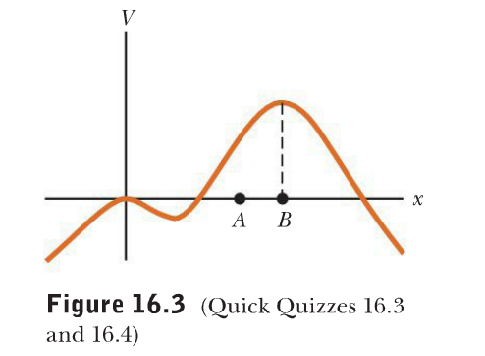 Figure is a graph of an electric potential as a function of position. If a positively charged particles is placed at point A, what will its subsequent motion be? Will it a) go the right b) go to the left c)remain at point A d) oscillate around point B | back 22 B |
front 23  If a negatively charged particle is placed at point B in Figure 16.3 and given a very small kick to the right, what will its subsequent motion be? a) go to the right and not return b)go to the left c)remain at point B d)oscillate around point B | back 23 D |
front 24 Consider a collection of charges in a give region and suppose all other charges are distant and have a negligible effect. Further, the electric potential is taken to be zero at infinity. If the electric potential at a given pint in the region is zero, which of the following statements must be true? a) The electric field is zero at that point b)The electric potential energy is a minimum at that point c)There is no net charge in the region d)Some charges in the region are positive, and some are negative e)The charges have the same sign and are symmetrically arranged around the given point | back 24 D |
front 25 A spherical balloon contains a positively charged particle at its center. As the balloon is inflated to a larger volume while the charged particle remains at the center, which of the following are true? a)The electric potential at the surface the balloon increases b)The magnitude of the electric field at the surface of the balloon increases c)The electric flux through the balloon remains the same d)None of these | back 25 C |
front 26 A capacitor is designed so the on e plate is large and the other is small. If the plates are connected to a battery. a) the large plate has a greater charge than the small plate b)the large plate has less charge than the small plate c)the plates have equal,but opposite,charge | back 26 C |
front 27 A parallel-plate capacitor is disconnected from a battery, and the plates are pulled a small distance farther apart. Do the following quantities increase, decrease, or stay the same? C a)increase b)decrease c)stay the same | back 27 B |
front 28 A parallel-plate capacitor is disconnected from a battery, and the plates are pulled a small distance farther apart. Do the following quantities increase, decrease, or stay the same? Q a)increase b)decrease c)stay the same | back 28 C |
front 29 A parallel-plate capacitor is disconnected from a battery, and the plates are pulled a small distance farther apart. Do the following quantities increase, decrease, or stay the same? E between the plates a)increase b)decrease c)stay the same | back 29 C |
front 30 A parallel-plate capacitor is disconnected from a battery, and the plates are pulled a small distance farther apart. Do the following quantities increase, decrease, or stay the same?Delta V a)increase b)decrease c)stay the same | back 30 A |
front 31 A parallel-plate capacitor is disconnected from a battery, and the plates are pulled a small distance farther apart. Do the following quantities increase, decrease, or stay the same? energy stored in the capacitor a)increase b)decrease c)stay the same | back 31 A |
front 32 A fully charged parallel-plate capacitor remains connected to a battery while a dielectric is slid between the plates. Do the following quantities increase, decrease, or stay the same? C a)increase b)decrease c)stay the same | back 32 A |
front 33 A fully charged parallel-plate capacitor remains connected to a battery while a dielectric is slid between the plates. Do the following quantities increase, decrease, or stay the same? Q a)increase b)decrease c)stay the same | back 33 A |
front 34 A fully charged parallel-plate capacitor remains connected to a battery while a dielectric is slid between the plates. Do the following quantities increase, decrease, or stay the same? E a)increase b)decrease c)stay the same | back 34 C |
front 35 A fully charged parallel-plate capacitor remains connected to a battery while a dielectric is slid between the plates. Do the following quantities increase, decrease, or stay the same? delta V a)increase b)decrease c)stay the same | back 35 C |
front 36 A fully charged parallel-plate capacitor remains connected to a battery while a dielectric is slid between the plates. Do the following quantities increase, decrease, or stay the same? energy stored in the capacitor a)increase b)decrease c)stay the same | back 36 A |
front 37 Consider a parallel-plate capacitor with a dielectric material between the plates. If the temperature of the dielectric increases, does the capacitance a)decrease b)increase c)remain the same | back 37 A |
front 38 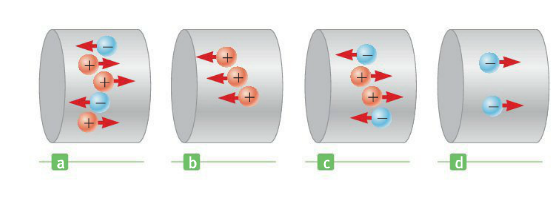 Consider Positive and negative charges all moving horizontally with the same speed through the four region in figure 17.2. Rank the magnitudes of the currents in these four regions from lowest to highest. a) Id ,Ia , Ic ,Ib b)Ia , Ic ,Ib Id c)Ic Ia Id Ib d)Id ,Ib Ic Ia , | back 38 D |
front 39 Suppose a current-carrying wire has a cross-sectional area that gradually becomes smaller along the wire so that the wire has the shape of a very long, truncated cone. How does the drift speed vary along the wire? a) It slows down as the cross section becomes smaller b) It speeds up as the cross section becomes smaller c) It doesn't change d) more information if needed | back 39 B |
front 40 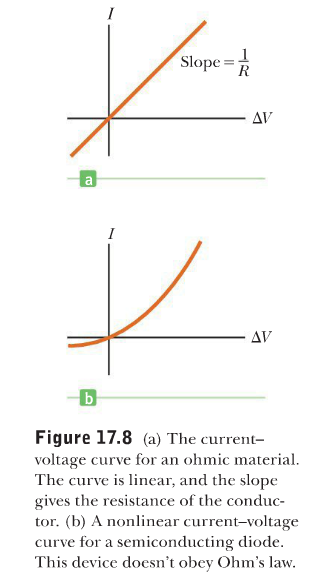 In Figure 17.8b does the resistance of the diode> a) increase b)decrease as the positive voltage Delta V increase. | back 40 B |
front 41 All electric devices are required to have identifying plate that specify their electrical characteristics. The plate on a certain steam iron states that the iron carries current of 6.0 A when connected to a source of 1.20x102 V. What is the resistance of the steam iron? a) 0.050 ohms b) 20.0 ohms c) 36.0 ohms | back 41 B |
front 42 Suppose an electrical wire is replaced with one having every linear dimension doubled (i.e. , the length and radius have twice their original values). Does the wire now have. a) more resistance than before b ) less resistance c) the same resistance | back 42 B |
front 43 A voltage delta V is applied across the end of a Nichrome heater wire having a cross-sectional A and length L. the same voltage is applied across the ends of a second Nichrome heater wire having a cross-sectional area A and length 2L. Which wire gets hotter? a)the shorter wire b)the longer wire c)more information is needed. | back 43 A |
front 44  For the two resistors show rank the currents at point a through f from largest to smallest. a)Ia=Ib>Ie=If>Ic=Id b)Ia=Ib>Ic=Id>Ie=If c)Ie=If>Ic=Id>Ia=Ib | back 44 B |
front 45 Two resistors, A and B, are connected in a series circuit with a battery. The resistance of A is twice that of B. Which resistor dissipates more power? a)A resistor does b)B resistor does c) more information is needed | back 45 A |
front 46 The diameter of wire A is greater than the diameter of wire B, but their lengths and resistivities are identical. For a given voltage difference across the ends, what is the relationship between P A and P B, the dissipated power for wires A and B, respectively? a)PA =P B b)P A< PB c) P A > B | back 46 C |
front 47 While discharging the terminal voltage of a battery can never be greater than the emf of the battery a)true b) false | back 47 A |
front 48 Why does the battery get warm while in use | back 48 Because the batteries internal resistance power, is delivered to the battery material, raising its temperature. |
front 49  The circuit in 18.4 consists of two resistors, a switch, an meter,
and a battery. When the switch is closed, power Pc is delivered to the
resistor R1. when the switch is open, which of the following
statements is true about the power P0 delivered to R1? | back 49 A |
front 50 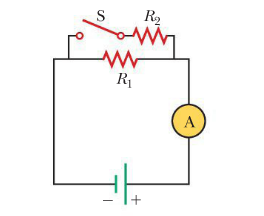 n figure 18.7, the current is measured with the ammeter on the right
side of the circuit diagram. When the switch is closed, does the
reading on the ammeter | back 50 A |
front 51 18.7, power P0 is delivered to the resistor R1. When the switch is
closed, which of the following is true about the Power Pc delivered to
R1? (Neglect the internal resistance of the battery) | back 51 B |
front 52 Suppose you have three identical lightbulbs, some wire, and a
battery. You connect one lightbulb to the battery and take note of its
brightness. You add a second lightbulb, connecting it in parallel with
the previous lightbulb, and again take note of the brightness. Repeat
the process with the third lightbulb, connecting it in parallel with
the other two. As the lightbulbs are added, what happens to | back 52 (a) the brightness of the lightbulbs? unchanged |
front 53 lightbulbs, some wire, and a battery. You connect one lightbulb to
the battery and take note of its brightness. You add a second
lightbulb, connecting it in series with the previous lightbulb, and
again take not of the brightness. Repeat the process with the third
lightbulb, connecting it in series with the other two. As the
lightbulbs are added, what happens to | back 53 (a) the brightness of the lightbulbs? decrease |
front 54 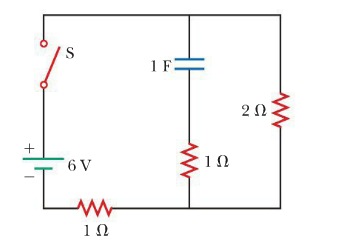 The switch in the closed in the figure. After a long time compared with the time constant of the circuit, what will the current be in the 2 Ohm resistor? a)4A b)3 A c) 2A d) 1A e) more information need | back 54 C |
front 55 A charged particle moves in a straight line through a region of
space. Which of the following answers must be true? (Assume any other
fields are negligible) The magnetic field | back 55 B |
front 56 The north pole end of a bar magnet is held near a stationary
postively charged piece of plastic. Is the plastic | back 56 C |
front 57 A square and a circular loop with the same area lie in the xy plane,
where there is a uniform magnetic field (B) pointing at some angle
(theta) with respect to the positive Z direction. Each loop carries
the same current, int he same direction. Which magnetic torque is
larger? | back 57 C |
front 58 As a charged particle movers freely in a circular path in the
presence of a constant magnetic field applied perpendicular to the
particles velocity, the particle's kinetic energy | back 58 A |
front 59 Which of the following actions would double the magnitude of the
magnetic force per unit length between two parallel current-carrying
wires? Chose all correct answers | back 59 A,C |
front 60 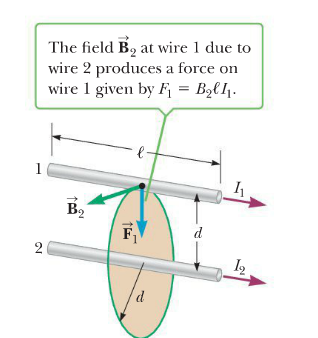 In figure 19.28, I1-2A and I2=6a, which of the following is true?
Note that F2 represents the magnet of the force on wire 2 | back 60 B |